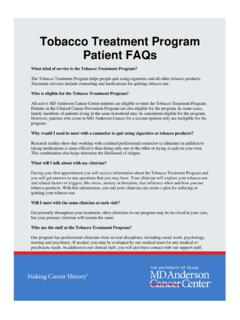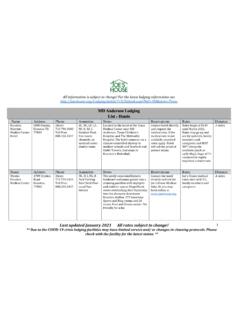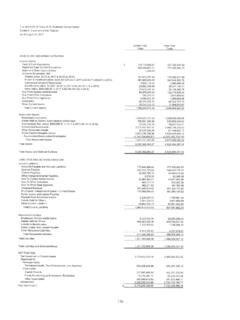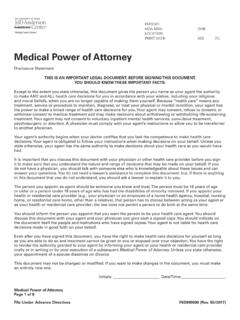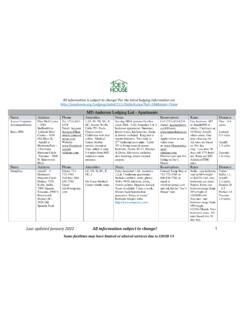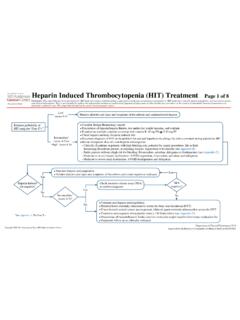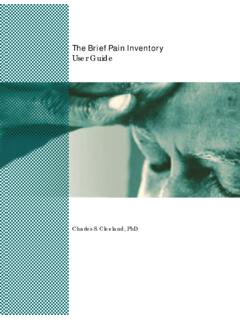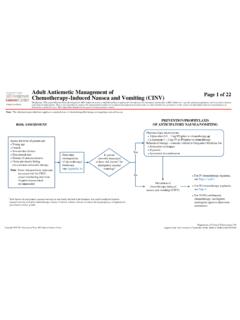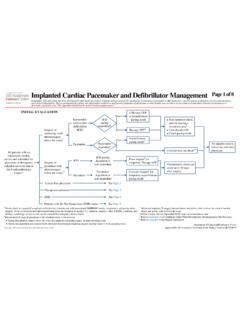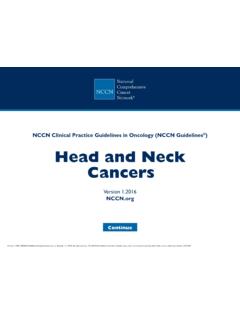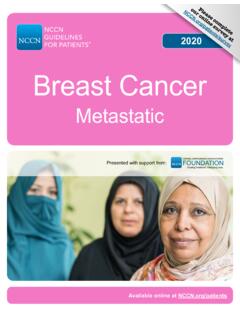Transcription of Anxiolysis (Minimal Sedation) for Procedures and Tests ...
1 Assess need for Anxiolysis prior to procedurePatient scheduled for procedure or testNote: Refer to UTMDACC Institutional Policy #CLN0502 for complete (Minimal Sedation) for Procedures and Tests Department of Clinical Effectiveness V4 Approved by the Executive Committee of the Medical Staff on 09/15/2020 Patient needs Anxiolysis ?TREATMENT Document mental status and vital signs prior to administering sedation Determine appropriate medication and dose based on onset of action (see chart below) of anxiolytic for desired patient responseContinue with procedureNoYesContinue with procedure and document mental status and vital signs after administering sedation and prior to beginning procedure and post-procedure11 If an admitted patient receives a dose of IV benzodiazepine for anxiolytic purposes within 30 minutes of a procedure or test, it is recommended that the patient is monitored according to standards [Refer to Sedation/Analgesia for Procedures Policy (MD anderson Institutional Policy # CLN0596)]2 Dosing adjustments.
2 Use lower doses for patients > 60 years, debilitated patients, hepatic or renal impairment, and in combination with narcotics or with other central nervous system (CNS) depressants3 Flumazenil is available for patients requiring reversal of anxiolytics4 Midazolam is preferred due to shorter half-life Discharge patient when clinically stable and follow institutional processes regarding discharge instructions and criteria for both inpatient and outpatient settings5 Pediatric considerations: Consider lower dosing strategies for patients with cardiac or respiratory compromise, and those who received concomitant opiates, benzodiazepines or similar synergistic sedative medications. Younger patients (6 months to < 6 years) and those less cooperative may require higher doses (up to 1 mg/kg/dose), may repeat one time dose within 30 minutes of initial dose if adequate response is not achieved.
3 Use lower initial doses in older patients (6 years to < 16 years)6 Pediatric resuscitative equipment should be available or easily accessible DrugAdult DoseRouteOnsetAdult Recommended Anxiolysis Dosing2,3 Midazolam4 Lorazepam DiazepamAlprazolam 5 10 2 mg1 4 mg5 10 mgPOPOIMPOPO10-30 minutes30-60 minutes20-30 minutes30 minutes60 minutesDrugPediatric DoseRouteOnsetMaximum DosePediatric Recommended Anxiolysis Dosing3,5,6 Midazolam 1 mg/kg/dose PO 10-20 minutes 5 mgPage 1 of 3 Disclaimer: This algorithm has been developed for MD anderson using a multidisciplinary approach considering circumstances particular to MD anderson s specific patient population, services and structure, and clinical information. This is not intended to replace the independent medical or professional judgment of physicians or other health care providers in the context of individual clinical circumstances to determine a patient's care.
4 This algorithm should not be used to treat pregnant , J. L. (1998). Clinical pharmacology of midazolam in infants and children. Clinical Pharmacokinetics, 35(1), 37-47. , C. J., Cohen, I. T., Suresh, S., Rabb, M., Rose, J. B., Weldon, B. C., .. Collins, P. (2002). A comparison of three doses of a commercially prepared oral midazolam syrup in children. Anesthesia and Analgesia, 94(1), 37-43. , C., Ziegler, W. H., Eckert, M., & Heizmann, P. (1983). Relationship between plasma concentration and effect of midazolam after oral and intravenous administration. British Journal of Clinical Pharmacology, 16(S1), 51S-61S. , J., Rodarte, A., Blumer, J., Khoo, K., Akbari, B., Kearns, G., & Pediatric Pharmacology Research Unit Network. (2000). Pediatric pharmacodynamics of midazolam oral syrup.
5 Journal of Clinical Pharmacology, 40(6), 578-589. , M. D., Rodarte, A., Blumer, J. L., Khoo, K., Akbari, B., Pou, S., & Pediatric Pharmacology Research Unit Network. (2001). The single-dose pharmacokinetics of midazolam and its primary metabolite in pediatric patients after oral and intravenous administration. Journal of Clinical Pharmacology, 41(12), 1359-1369. , J., MD. (2011). Adding intranasal lidocaine to midazolam may benefit children undergoing procedural sedation. Journal of Pediatrics, 159(1), 166-166. READINGSD epartment of Clinical Effectiveness V4 Approved by the Executive Committee of the Medical Staff on 09/15/2020 Anxiolysis (Minimal Sedation) for Procedures and Tests Page 2 of 3 Disclaimer: This algorithm has been developed for MD anderson using a multidisciplinary approach considering circumstances particular to MD anderson s specific patient population, services and structure, and clinical information.
6 This is not intended to replace the independent medical or professional judgment of physicians or other health care providers in the context of individual clinical circumstances to determine a patient's care. This algorithm should not be used to treat pregnant practice consensus statement is based on majority opinion of the Anxiolysis experts at the University of Texas MD anderson cancer center for the patient population. These experts included:DEVELOPMENT CREDITSThao Bui, MD (Anesthesiology and PeriOperative Medicine)Richard Carlson III, MD (Anesthesiology and PeriOperative Medicine) Marta Davila, MD (Gastroenterology Hepatology and Nutrition)Brian Dee, PharmD (Pharmacy Clinical Programs) Wendy Garcia, BS Katherine Hagan, MD (Anesthesiology and PeriOperative Medicine)Harjeet Kaur, MSN, RN, CNL, CMQ Maria Estela Mireles, PharmD (Pharmacy Clinical Programs) Amy Pai, PharmD, BCPS Huang Steven, MD (Interventional Radiology)Danna Stone, RN, MBA (Diagnostic Imaging-Clinical) Alda Lui Tam, MD (Interventional Radiology)Shannon Worchesik, RN, MBA (Diagnostic Imaging-Nursing)
7 Core Development T eam Lead Clinical Effectiveness Development TeamDepartment of Clinical Effectiveness V4 Approved by the Executive Committee of the Medical Staff on 09/15/2020 Anxiolysis (Minimal Sedation) for Procedures and Tests Page 3 of 3 Disclaimer: This algorithm has been developed for MD anderson using a multidisciplinary approach considering circumstances particular to MD anderson s specific patient population, services and structure, and clinical information. This is not intended to replace the independent medical or professional judgment of physicians or other health care providers in the context of individual clinical circumstances to determine a patient's care. This algorithm should not be used to treat pregnant women.
